 All papers examples
All papers examples
Disciplines

- MLA
- APA
- Master's
- Undergraduate
- High School
- PhD
- Harvard
- Biology
- Art
- Drama
- Movies
- Theatre
- Painting
- Music
- Architecture
- Dance
- Design
- History
- American History
- Asian History
- Literature
- Antique Literature
- American Literature
- Asian Literature
- Classic English Literature
- World Literature
- Creative Writing
- English
- Linguistics
- Law
- Criminal Justice
- Legal Issues
- Ethics
- Philosophy
- Religion
- Theology
- Anthropology
- Archaeology
- Economics
- Tourism
- Political Science
- World Affairs
- Psychology
- Sociology
- African-American Studies
- East European Studies
- Latin-American Studies
- Native-American Studies
- West European Studies
- Family and Consumer Science
- Social Issues
- Women and Gender Studies
- Social Work
- Natural Sciences
- Anatomy
- Zoology
- Ecology
- Chemistry
- Pharmacology
- Earth science
- Geography
- Geology
- Astronomy
- Physics
- Agriculture
- Agricultural Studies
- Computer Science
- Internet
- IT Management
- Web Design
- Mathematics
- Business
- Accounting
- Finance
- Investments
- Logistics
- Trade
- Management
- Marketing
- Engineering and Technology
- Engineering
- Technology
- Aeronautics
- Aviation
- Medicine and Health
- Alternative Medicine
- Healthcare
- Nursing
- Nutrition
- Communications and Media
- Advertising
- Communication Strategies
- Journalism
- Public Relations
- Education
- Educational Theories
- Pedagogy
- Teacher's Career
- Statistics
- Chicago/Turabian
- Nature
- Company Analysis
- Sport
- Paintings
- E-commerce
- Holocaust
- Education Theories
- Fashion
- Shakespeare
- Canadian Studies
- Science
- Food Safety
- Relation of Global Warming and Extreme Weather Condition
Paper Types

- Movie Review
- Essay
- Admission Essay
- Annotated Bibliography
- Application Essay
- Article Critique
- Article Review
- Article Writing
- Assessment
- Book Review
- Business Plan
- Business Proposal
- Capstone Project
- Case Study
- Coursework
- Cover Letter
- Creative Essay
- Dissertation
- Dissertation - Abstract
- Dissertation - Conclusion
- Dissertation - Discussion
- Dissertation - Hypothesis
- Dissertation - Introduction
- Dissertation - Literature
- Dissertation - Methodology
- Dissertation - Results
- GCSE Coursework
- Grant Proposal
- Admission Essay
- Annotated Bibliography
- Application Essay
- Article
- Article Critique
- Article Review
- Article Writing
- Assessment
- Book Review
- Business Plan
- Business Proposal
- Capstone Project
- Case Study
- Coursework
- Cover Letter
- Creative Essay
- Dissertation
- Dissertation - Abstract
- Dissertation - Conclusion
- Dissertation - Discussion
- Dissertation - Hypothesis
- Dissertation - Introduction
- Dissertation - Literature
- Dissertation - Methodology
- Dissertation - Results
- Essay
- GCSE Coursework
- Grant Proposal
- Interview
- Lab Report
- Literature Review
- Marketing Plan
- Math Problem
- Movie Analysis
- Movie Review
- Multiple Choice Quiz
- Online Quiz
- Outline
- Personal Statement
- Poem
- Power Point Presentation
- Power Point Presentation With Speaker Notes
- Questionnaire
- Quiz
- Reaction Paper
- Research Paper
- Research Proposal
- Resume
- Speech
- Statistics problem
- SWOT analysis
- Term Paper
- Thesis Paper
- Accounting
- Advertising
- Aeronautics
- African-American Studies
- Agricultural Studies
- Agriculture
- Alternative Medicine
- American History
- American Literature
- Anatomy
- Anthropology
- Antique Literature
- APA
- Archaeology
- Architecture
- Art
- Asian History
- Asian Literature
- Astronomy
- Aviation
- Biology
- Business
- Canadian Studies
- Chemistry
- Chicago/Turabian
- Classic English Literature
- Communication Strategies
- Communications and Media
- Company Analysis
- Computer Science
- Creative Writing
- Criminal Justice
- Dance
- Design
- Drama
- E-commerce
- Earth science
- East European Studies
- Ecology
- Economics
- Education
- Education Theories
- Educational Theories
- Engineering
- Engineering and Technology
- English
- Ethics
- Family and Consumer Science
- Fashion
- Finance
- Food Safety
- Geography
- Geology
- Harvard
- Healthcare
- High School
- History
- Holocaust
- Internet
- Investments
- IT Management
- Journalism
- Latin-American Studies
- Law
- Legal Issues
- Linguistics
- Literature
- Logistics
- Management
- Marketing
- Master's
- Mathematics
- Medicine and Health
- MLA
- Movies
- Music
- Native-American Studies
- Natural Sciences
- Nature
- Nursing
- Nutrition
- Painting
- Paintings
- Pedagogy
- Pharmacology
- PhD
- Philosophy
- Physics
- Political Science
- Psychology
- Public Relations
- Relation of Global Warming and Extreme Weather Condition
- Religion
- Science
- Shakespeare
- Social Issues
- Social Work
- Sociology
- Sport
- Statistics
- Teacher's Career
- Technology
- Theatre
- Theology
- Tourism
- Trade
- Undergraduate
- Web Design
- West European Studies
- Women and Gender Studies
- World Affairs
- World Literature
- Zoology
Diving Reflex, Lab Report Example
Hire a Writer for Custom Lab Report
Use 10% Off Discount: "custom10" in 1 Click 👇
You are free to use it as an inspiration or a source for your own work.

Research Question
The purpose of the lab was to develop an understanding of the diving reflex in mammals. The research question for the lab is ‘How does water temperature affect the pulse in mammals?”
Background Information
The diving reflex in mammals is correlated with receptors found in the cranial nerve in the face, nose and mouth. The nerve responds to changes in the temperature of water and through receptors. The receptors are found in the nasal and pharyngeal areas in mammals, and under certain environmental and physiological changes, stimulate a reflex referred to as apnea or cessation of breathing. (St. Louis University, 1). Marine mammals, in particular, have been the subjects of extensively research in regard to the diving reflex. Studies have used various marine animals, such as cetaceans (whales and dolphins), seals, walruses, sirenians, and penguins. In the current laboratory experiment, the focus is on mammalian response to diving. Previous research using the Weddell seal has provided mammalian physiological research on the diving reflex. The Weddell seal was studied since this particular seal dives to depths up to 800 ft on a regular basis in the Antarctic Ocean. In fact, the seals have been recorded to making dives for almost 1.5 hours in depths of 2,300 feet. The curiosity of how the mammals are able to manage the lack of oxygen while submerged for long periods of time becomes a topic of interest. According to Robert Maue of Dartmouth Medical School, the seals use the diving reflex to manage the decrease in oxygen, as well as other physiological functions, such as digestion, blood circulation, and heart rate. Research found that during the dive, the seal’s heart rate slowed, further indicating that the blood circulation decreased throughout the body. In addition, it was found that metabolic processes also decreased in order to decrease the use of energy. (DUJS)
In the current lab, the heart rate (pulse) of human mammals will be investigated during a simulated dive. A varying number of factors associated with underwater submersion will be included in order to correlate factors of submersion that correspond to the diving reflex.
Hypothesis
The diving reflex is a human physiological response to changes in the environment. The hypothesis for the current experiment states that the pulse rate (beats/minute) in an individual will decrease with decreasing temperature. A second hypothesis states that the pulse rate (beats/minute) will decrease in individuals submerged under water, compared to air.
Variables
- Independent Variable: pulse rate.
Dependent Variable: At rest, dry Apnea, diving, recovery phases.
Controlled Variable: Temperature
Apparatus
- Chair
Stopwatch
Thermometer (Celsius scale)
Bowl
Ice
Hot Plate or Warmer
200 L Beaker
Method
Five individuals were asked to participate in the study. The individuals were all students aged 15-17, and 3 male and 2 female. The individuals were informed of the experiment and the need for submersion under water. The individuals were asked to sit and relax in a chair for five minutes prior to the study. The heart rate was measured for each individual at rest using their pulse via wrist method. In order to investigate any effect of dry apnea (holding breath without submersion under water), the individuals were asked to hold their breath for 30 seconds while sitting in the chair. The pulse was measured and the data was recorded. In order to measure apnea under submersion, the individuals face was submerged in a bowl of water at room temperature (20°C) for 30 seconds. The investigator tapped the individual on the shoulder every 10 seconds to inform the volunteer of the time passed and to reduce anxiety or stress. The pulse was taken during the last 15 seconds of the submersion. The pulse was measured for pulse within 15 seconds and then multiplied by 4 to calculate the pulse per minute. In addition, the pulse was taken at 30 seconds, 60 seconds, and 90 seconds after being submerged and referred to as recovery pulse. The experiment was repeated using different temperatures in the submersion bowl. One bowl was filled with ice to obtain a temperature of 15°C and another bowl was warmed to a warm temperature to obtain a temperature of 25°C, both temperatures were recorded. There were a total of 3 trials for each factor and each individual.
The average percent change in pulse for dry apnea; diving and recovery were calculated and recorded. An ANOVA was conducted in order to obtain a correlation between the factors and determine at which temperature the diving reflex had the most effect.
Data Collection and Procsesing (Dcp)
Collected Data
Table 1. Data Recorded at for three trials at room temperature for five individuals

Table 2. Data Recorded at for three trials at cold temperature for five individuals
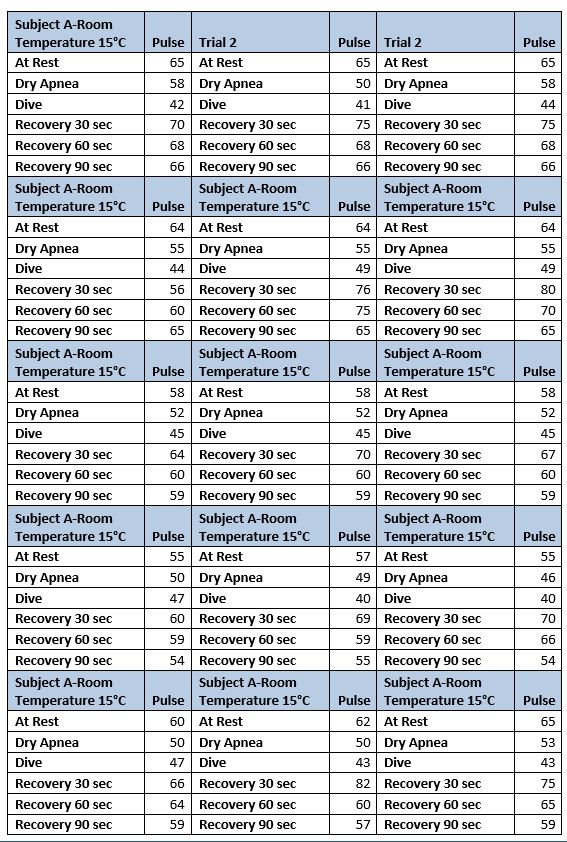
Table 3. Data Recorded at warm temperature for five individuals.
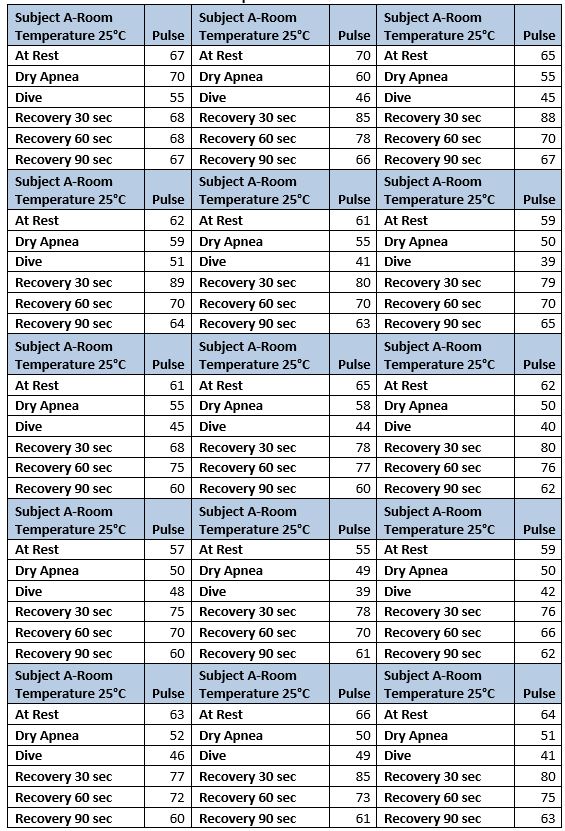
Data Processing
Table 4. Average Pulse (beats/minute) for each Subject at differing factors in water submersion 20°C
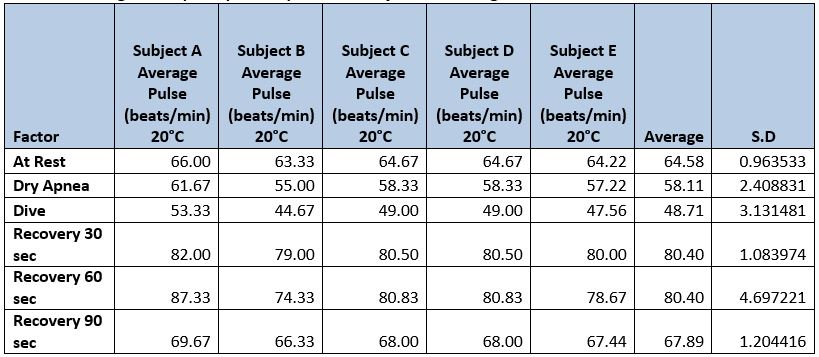
Table 5. Average Pulse (beats/minute) for each Subject at differing factors in water submersion 15°C
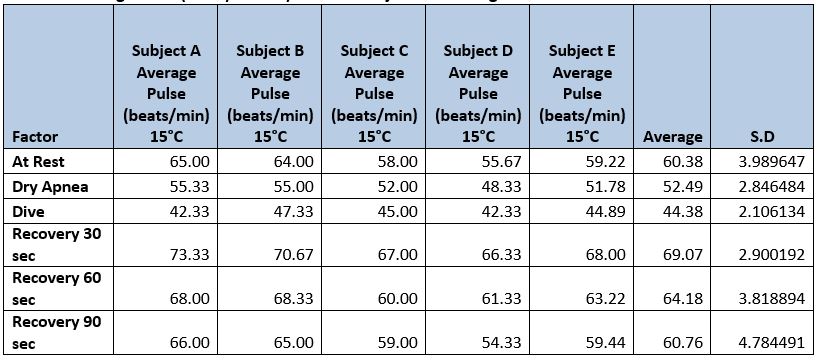
Table 6. Average Pulse (beats/minute) for each Subject at differing factors in water submersion 25°C
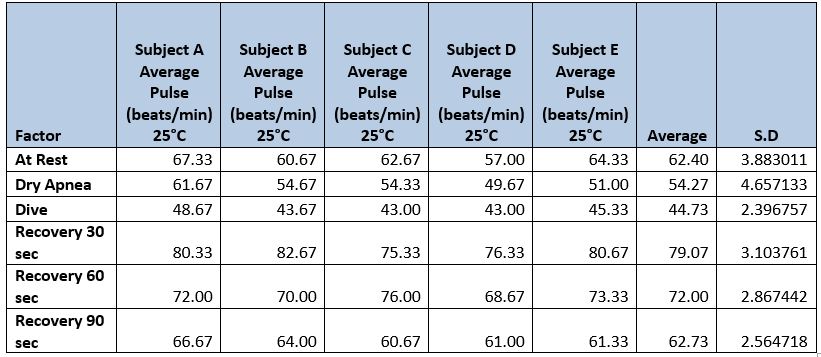
Table 7. ANOVA results between conditions. *=P-Value < 0.05
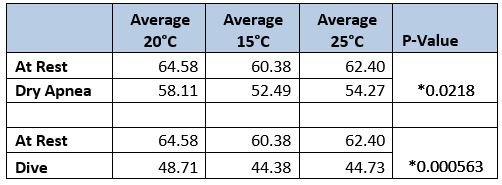
Errors/Uncertainties
Table 8. Percent Change in Pulse Rates (Breathes/min) from At Rest.
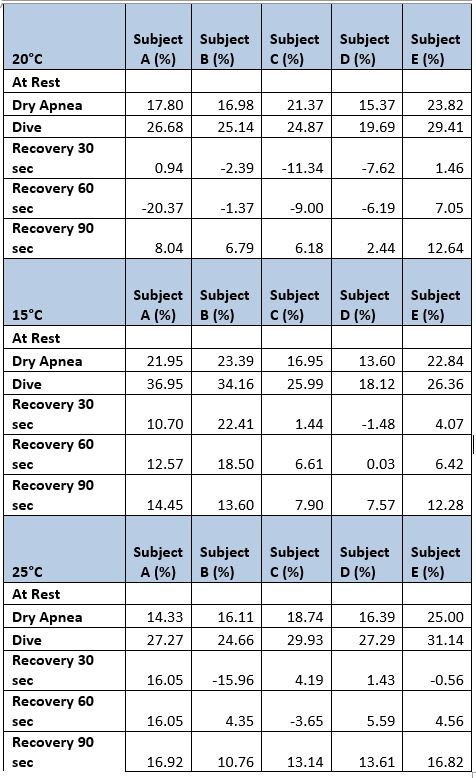
Data Presentation
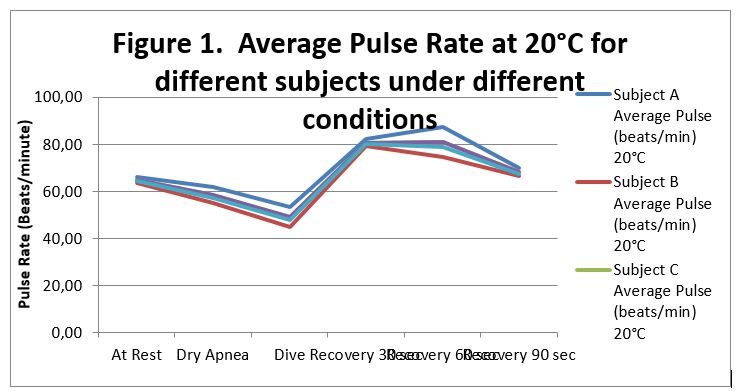
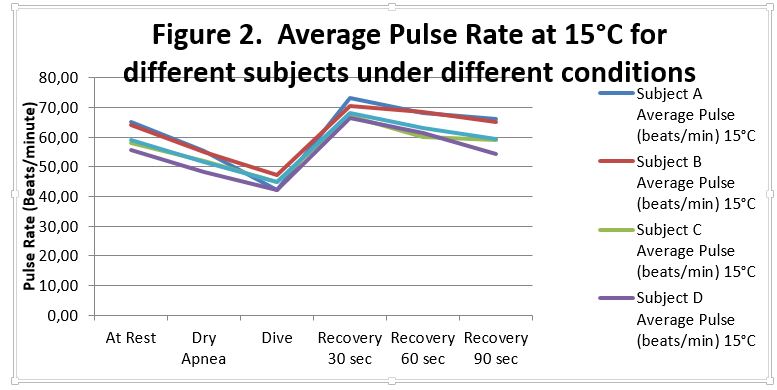
Conclusion and Evaluation (Ce)
The results of the diving experiment support the hypothesis that the pulse rate will decrease with decreasing temperature and decrease under water compared to air. Table 4, 5, and 6 shows the average pulses of ea
ch individual subjects at rest, during dry apnea, during diving, and recovery phases at 30, 60 and 90 seconds after diving. The results show a decrease in average pulse rate during dry apnea and diving. (Figure 1) Figure 1, 2, and 3 show the average pulse rates of all individuals combined for dry apnea, diving, and recovery. Again, the results show a decrease in pulse rate during dry apnea and diving. The average pulse rates were examined for all subjects combined to evaluate the differences between the temperature overall. As seen in Figure 4, the lowest pulse levels were measured at 15°C, which supports the hypothesis that the pulse rate would decrease with decreasing temperature. Standard deviation was also conducted and ranged from 2-4 beats/minute when conducted over the average for all subjects. This is expected given subjects were male and female and average pulses could vary. An ANOVA test was conducted in order to show the relationship between the average results of pulse rate at rest and between dry apnea and diving. The results show a significant difference between the factors. The significance level was 95% and the p-value for both results was below 0.05, indicating a significant difference between values. This shows that the average pulse rates during diving and during dry apnea are significantly different than at rest, further supporting the diving reflex theory. (Table 7) It can be therefore suggested that the receptors in the cranial nerve set in the diving reflex immersion in the water, since this had the overall lowest average pulse rate.
Evaluation and Improvement Methods
The results of the percent error were calculated as percent change from the pulse rate at rest and are illustrated in Table 8. The percent changes were highest during dry apnea and diving, as expected.
There were some set-backs in the experiment, such as the need to measure blood pressure. In order to obtain a better measurement, the use of a blood pressure meter, or perhaps a pulse reader would provide more accurate measurements. The pulse was taken using the wrist method; therefore, pulse measurements may be inaccurate. Additional factors should also be measured, such as age, weight, and activity level in subjects, such as athletics. Athletic individuals may have a lower pulse rate compared to non-athletes.
Works Cited
DUJS. The mammalian diving reflex. Dartmouth Undergraduate Journal of Science. (2012) Retrieved from: http://dujs.dartmouth.edu/winter-2012/the-mammalian-diving-reflex#.Uzeb4PldVJI
St. Louis University. Diving Physiology Lab. Retrieved from: http://www.penguinprof.com/uploads/8/4/3/1/8431323/261_labs_u2_diving_reflex_lab.pdf

Stuck with your Lab Report?
Get in touch with one of our experts for instant help!
Tags:

Time is precious
don’t waste it!
writing help!


Plagiarism-free
guarantee

Privacy
guarantee

Secure
checkout

Money back
guarantee

